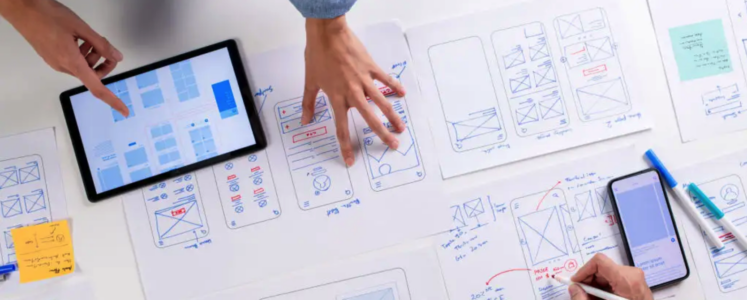How Product Owners Work with UX/UI Designers

The collaboration between product owners (POs) and UX/UI designers is essential to create user-centered products that align with business goals. While product owners focus on defining and prioritizing product features based on user and business needs, UX/UI designers ensure that these features provide a seamless, engaging user experience. Here’s a closer look at how product owners work effectively with UX/UI designers to deliver successful products.
1. Aligning on Product Vision and Goals
To create a unified product strategy, product owners and UX/UI designers first need a shared understanding of the product’s vision and goals. This alignment ensures that the product not only meets functional requirements but also delights users.
- Product owners communicate the business objectives, target audience, and high-level goals to give designers context for their work. This includes explaining the product’s purpose, intended market positioning, and key performance indicators (KPIs).
- Designers provide insights on how user experience contributes to these goals, sharing their expertise on user behavior, design trends, and usability. This helps product owners see how UX/UI decisions can directly impact product success.
Regular alignment meetings between POs and UX/UI designers ensure both parties are moving in the same direction and can make informed decisions about prioritizing features and design elements that align with the overall product vision.
2. Collaborating on User Research and Persona Development
User research is crucial to understanding the needs, preferences, and pain points of the target audience. Product owners and UX/UI designers often collaborate closely during this phase to gather and analyze data that shapes the product’s design and functionality.
- Product owners outline key user segments and business goals, ensuring that research efforts focus on the most relevant areas. They may also provide access to customer insights and analytics that reveal patterns in user behavior.
- UX/UI designers conduct qualitative and quantitative research, using methods like user interviews, surveys, and usability testing to collect data. Designers then analyze this data to create user personas and empathy maps that visualize user needs and motivations.
Through collaboration, POs and designers develop a comprehensive understanding of user requirements and build personas that guide design and feature decisions. This user-centered approach ensures the final product resonates with the target audience.
3. Defining and Prioritizing Features Together
Feature prioritization is a core responsibility of the product owner, who considers business impact, user value, and development complexity when creating the product backlog. By involving UX/UI designers in this process, POs ensure that design perspectives are considered in feature prioritization.
- Product owners outline high-priority features based on business strategy, often breaking down complex projects into user stories or epics that explain the desired functionality from the user’s perspective.
- UX/UI designers provide feedback on how each feature impacts the user experience and may suggest changes to make features more intuitive, efficient, or visually appealing. They also estimate the design time required, which helps product owners balance feature priorities with design timelines.
This collaboration ensures that the product backlog reflects features that balance business needs and user experience, leading to a more cohesive product.
4. Creating and Refining Wireframes and Prototypes
Wireframes and prototypes are essential for visualizing how features will look and function. Product owners work with UX/UI designers during this phase to refine concepts and ensure alignment with the product vision.
- Product owners provide input on the functionality, layout, and information hierarchy, clarifying how each feature should work to achieve business goals.
- UX/UI designers create wireframes and prototypes to provide a visual representation of the product. These prototypes range from low-fidelity sketches to high-fidelity interactive models, which allow both teams to experiment with layouts, workflows, and interactions.
Through feedback cycles, product owners and designers fine-tune prototypes until they’re confident that the product layout, navigation, and interactions align with user needs and business objectives.
5. Conducting Usability Testing and Gathering Feedback
Usability testing helps identify design improvements before development begins. Product owners and UX/UI designers collaborate to test the product with real users, gathering data on its ease of use, functionality, and visual appeal.
- Product owners help select testing criteria and define success metrics, such as task completion rates, error frequency, and user satisfaction scores. These metrics align with broader product goals, helping measure the effectiveness of the design.
- Designers conduct usability testing sessions, observing how users interact with the product and noting any challenges or points of confusion. Designers then analyze the results, identifying areas for improvement and potential adjustments to the user interface.
Both product owners and designers review test results to make data-informed decisions about necessary design changes, ensuring that any updates improve the user experience without sacrificing business goals.
6. Iterating Based on User and Stakeholder Feedback
In agile environments, iteration is key to refining products based on ongoing user and stakeholder feedback. Product owners and UX/UI designers collaborate closely during each iteration to ensure that changes continue to meet user and business needs.
- Product owners communicate feedback from stakeholders, such as executives or clients, ensuring that design updates align with strategic objectives and organizational priorities.
- UX/UI designers incorporate this feedback into the design, making adjustments that address user feedback without compromising usability or aesthetic appeal.
By working together, product owners and designers balance stakeholder expectations with the needs of the end-users, ensuring that updates enhance the product without over-complicating the user interface.
7. Building and Supporting a Design System
Design systems create consistency across products by establishing guidelines for colors, typography, icons, and other UI elements. Product owners and UX/UI designers often collaborate to build and maintain these systems, ensuring they support both usability and brand identity.
- Product owners define the requirements for brand consistency and feature scalability, helping the design system support the product’s growth.
- Designers create and document design components, ensuring that each element aligns with usability standards and visual coherence.
With a shared design system in place, designers can efficiently create new features and maintain consistency, while product owners can ensure scalability and brand integrity across all product iterations.
8. Facilitating Communication Between Development Teams
After finalizing designs, product owners and UX/UI designers collaborate to communicate design intent clearly to development teams. This partnership helps ensure that designs are implemented accurately and within project timelines.
- Product owners act as liaisons between designers and developers, translating design priorities and functional requirements into user stories and acceptance criteria.
- Designers work closely with developers, providing assets, style guides, and clarifications as needed to ensure that the user experience is implemented as intended.
Clear communication between product owners, designers, and developers reduces misinterpretations and enhances the efficiency of the development process, leading to a smoother product launch.
9. Evaluating Success with Metrics and Analytics
After launch, product owners and UX/UI designers use data and analytics to evaluate the product’s performance and impact. By analyzing user behavior, they can assess how well the product meets both business goals and user expectations.
- Product owners focus on high-level KPIs, such as conversion rates, retention, and engagement, using these metrics to assess if the product is meeting its business objectives.
- Designers analyze user behavior data, such as click paths, heatmaps, and drop-off points, to understand how users navigate the interface and identify areas for improvement.
Using these insights, product owners and designers collaborate to refine the product in future releases, making data-informed adjustments that continuously enhance the user experience and achieve greater alignment with business goals.
Conclusion
The collaboration between product owners and UX/UI designers is foundational to creating products that meet user needs and business objectives. By aligning on goals, conducting thorough research, and working together through each project phase, POs and designers ensure the product is user-centered, strategically prioritized, and consistently improved through data and feedback. With a strong partnership, product owners and UX/UI designers can deliver high-quality products that meet market demands and drive long-term success.


